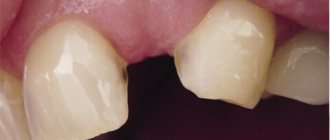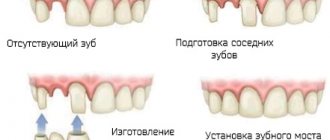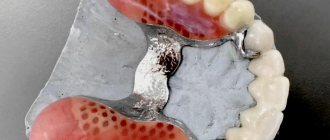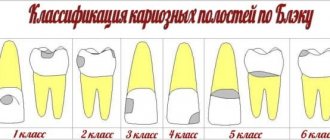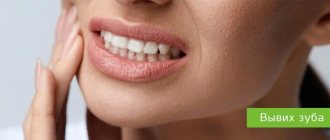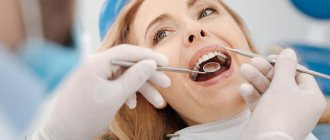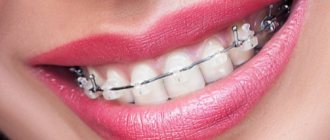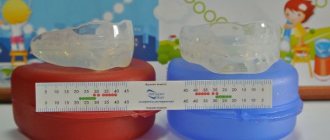Congenital pathologies of the tongue and frenulum - types and features
Anomalies of the tongue can be either congenital or acquired; they are often the result of certain pathological processes occurring in the body. Currently, malformations of the main speaking organ are quite rare. Many of them are serious problems that often require surgery. Further in this article we will talk about what congenital defects of the tongue and frenulum exist, how they are corrected, and also consider in detail such a pathology as a folded tongue.
Types of congenital anomalies
Currently, in medicine and dentistry in particular, a specific list of main pathologies is identified, each of which has its own deviations. Anomalies of the development of the main organ of the oral cavity include the following disorders:
- aglossia is a rare anomaly in which the tongue is completely absent,
- microglossia - the absence of the front part of the organ, due to which it has an abnormally small size, becomes too short,
- macroglossia - in this case the organ grows excessively, which is accompanied by generalized hypertrophy of the jaw muscles,
- splitting - its two parts are separated vertically, they simply do not grow together, remaining completely separate from each other. This tongue resembles a snake's,
- lingual tonsils - enlarged lymph nodes in the root area of the organ,
- rhomboid glossitis - characterized by the formation of an inflamed area in the shape of an oval or diamond at the base, usually blue-red in color,
- folding is a defect in size and shape, in which deep grooves and folds covered with papillae appear on the surface of the organ,
- a villous (hairy) tongue is a rather rare phenomenon, leading to hardening of overgrown filiform papillae. As a result, the area at the root turns brown or even black,
- Tongue goiter is a pathology in which thyroid tissue develops inside the organ and manifests itself as an uneven surface.
Modern medicine in most cases corrects such defects - in such situations, the problem of aesthetics and functionality is solved through surgery and plastic surgery.
Congenital malformations of the oral cavity and pharynx
Arlessia and microglossia as isolated anomalies. Unilateral microglossia is one of the signs of combined defects of the 1st and 2nd branchial arches, with a median cleft of the lower jaw, Robin's anomaly. Aglossia is observed extremely rarely with severe hypoplasia of the face and jaws in non-viable fetuses. Macroglossia is an excessive enlargement of the tongue with pronounced folding of the mucous membrane. Often combined with macrogenic. It occurs relatively often, especially in children with Down syndrome and hypothyrsoid cretinism. Macroglossia can be a consequence of vascular tumors (lymphomas or hemangiomas) of the body or coria of the tongue. Dominant forms of transmission are known. Treatment is surgical. Accessory tongue - the presence of an additional mucous-muscular protrusion at the root of the tongue. In appearance and mobility it resembles a tongue, only much smaller in size. An extremely rare defect. It must be differentiated from the accessory lobe of the thyroid gland. Treatment is surgical. Tongue frenulum - attachment of the frenulum at the tip of the tongue or its shortening, leading to limited mobility of the tongue, which makes sucking movements difficult for infants. The extreme degree of such an anomaly is accretion of the tongue. In the clinic, tongue frenulum is common. Treatment is surgical in infancy or childhood. Small vestibule of the oral cavity is an anomaly of the soft tissues of the anterior part of the alveolar process of the lower jaw, consisting of a sharp narrowing or complete absence of the zone of attached mucous membrane below the gingival margin.
Normally, this zone averages 5-6 mm. The attached mucous membrane plays a protective, buffering function for the dental papillae, which are subject to constant trauma when biting, during mouth movements and other movements of the lip. If the zone of attachment of the gum is narrow, then traumatic movements are transmitted to the papillae, they are constantly pulled back and peeled off from the roots of the teeth, inflammation appears, and pathological periodontal pockets are gradually formed. As a result of the steady progression of the inflammatory-dystrophic process in the soft tissues and bones, the sockets and roots of the teeth are exposed, the teeth become loose and fall out at a young age. The frequency of the anomaly is 6.9 and 5.3%, respectively, among children and adults.
Treatment is surgical.
Dental defects are frequent and varied. There are four main groups: 1st - anomalies in number, size and shape; 2nd - violation of the structure of the teeth; 3rd - position anomalies; 4th - violation of the timing of eruption and growth. Group 1 includes complete or partial adentia, supercomplex and fused teeth, underdevelopment (microdentia) or excessive development (macrodentia) of teeth, as well as anomalies in the shape of the crown, root or all parts of the tooth. Group 2 includes cases of aplasia, hypoplasia, enamel dysplasia, and dentin. Group 3 includes cases of retention and semi-retention of teeth; teeth standing outside the arch or rotated axes, and, finally, to the 4th group - growth disorders in the form of slow or accelerated tooth growth, as well as accelerated or slow teething.
Hereditary forms of dental malformations often accompany syndromes of multiple defects, both monogenic and chromosomal.
The nature of treatment depends on the type of anomaly and can be conservative or surgical. Some dental defects cannot be treated at all.
Diastema. Slight deformation of the front teeth in the upper jaw in the form of a wide gap between the central incisors. Its degree varies: from barely noticeable to 6.5 cm and wider. As a rule, it is accompanied by a low-lying frenulum. Treatment is orthodontic, sometimes surgical. Anomalies of the salivary glands are rare. Aplasia, hypoplasia of individual glands and dystopia of the gland in the cheek area are known. Unilateral hypoplasia of the major salivary glands is observed in syndromes of the 1st and 2nd branchial arches.
Treatment is problematic; sometimes surgical relocation of the duct (gland) is possible.
Pharyngeal bursa (Thornwald disease) is a cyst-like formation of the nasopharynx, located in the midline near the pharyngeal tonsil. The origin is associated with the peeling off of part of the endoderm in the region of the dorsal chord in the embryonic period. It is rare, the prognosis is favorable. Treatment is surgical.
Congenital pathology of the frenulum
Separately, it is worth highlighting the independent pathology of the frenulum of the tongue - the part attached to its center from below. There are also frenulums of the upper and lower lips - they join the mucous membrane in the area of the central incisors. In normal development, the hyoid ends right in the center of the organ, while in a disorder called ankyglossia, it is located too close to its tip - this anatomical abnormality is often called a short frenulum.
Congenital pathology of the frenulum of the tongue
On a note! Today, cases of ankyglossia occur in one child out of a thousand. Moreover, this pathology is diagnosed almost three times more often in boys than in girls1.
With this pathology, at the stage of breastfeeding, the baby is unable to latch onto the breast normally. Later, the child will experience certain difficulties in speech, will not be able to pronounce individual sounds and stick out his tongue far. Often there are disturbances in the formation of the dental system as a whole, and displacement of teeth is observed due to improper functioning of the tongue.
“I remember when I was a child my bridle was cut. True, I can’t say that I experienced any serious difficulties while talking or eating. It’s just that at the next examination at the dentist, he said that it was better to trim it so that the jaw would continue to form correctly, it seems like that. In general, the procedure was simple, there was generally no pain..."
Arthur H., Tolyatti, from correspondence on a thematic forum
Today, if this anomaly is detected, it can be corrected in the maternity hospital. At this age, the frenulotomy procedure is absolutely painless and does not require anesthesia, since there are no nerve endings in these tissues. In other cases, the operation is performed in preschool or school age as prescribed by a dentist. There is also an option for the so-called frenulum stretching - a speech therapist works with the problem. However, you should contact this doctor in any case if the frenulum is cut after the child has already learned to speak, because a new pronunciation will be required, taking into account the correct position of the tongue.
What are mouth guards in orthodontics?
Mouth guards are special designs used to correct malocclusion and dental defects. Unlike braces, they are outwardly invisible and do not interfere with diction.
Features and advantages of mouth guards:
- have a transparent plastic or silicone base;
- you can remove it yourself and carry out thorough hygienic care;
- soft structure that does not injure the oral cavity and does not damage tooth enamel;
- aesthetic designs ensure a tight fit to the teeth;
- do not create discomfort for the patient;
- do not require restrictions on food intake.
The only disadvantages of orthodontic aligners include their higher cost compared to braces, as well as a longer treatment period.
Indications for wearing mouth guards:
- slight curvature of teeth;
- rotation, crooked teeth;
- large gaps between crowns;
- elongation or shortening of dental alveoli;
- abnormal position of the upper canines;
- crossbite (effectively handled by McNamara mouthguard
).
Orthodontics
considers other indications for wearing a mouthguard. Such designs have an undeniable mass of advantages, are easy to maintain and completely invisible to others. They are made in dental laboratories individually for each patient using a dental impression. Installing the aligners takes only a few minutes.
Orthodontic aligners are also used to consolidate the results after wearing braces.
What is scrotal (folded) glossitis - the causes of the anomaly
Scrotal glossitis, or simply folded tongue, is one of the most common congenital pathologies of the tongue, in which during its development the organ acquires an irregular shape and non-standard size. This defect occurs in both children and adults, and the grooves can cover not only a limited area of the surface, but the entire tongue.
On a note! The problem in question may be congenital or acquired. In most cases, it does not pose a serious threat, but it significantly increases the risk of infection and, as a consequence, the development of inflammatory processes.
The photo shows a folded tongue
Typically, this deviation is formed at the stage of intrauterine development and becomes a consequence of an acute deficiency of vital microelements or genetic disorders. Experts identify a number of other factors that may contribute to the problem:
- the presence in the human body of chronic diseases of the gastrointestinal tract and liver,
- diseases of the skin and circulatory organs,
- disruptions in the functioning of the endocrine and nervous systems,
- infectious diseases in acute form,
- collagenoses are a group of diseases leading to pathological changes in connective tissues,
- disturbances in the trophic function of the organ mucosa,
- lack of vitamins and microelements important for the health of the body.
Sometimes such grooves can appear against the background of a sharp restructuring of the body, for example, during pregnancy. If the folds on the surface are not very pronounced and the person does not focus attention on this, he may not be aware of the abnormal development of his tongue.
Classification of anomalies of the dentofacial system
Bite defects develop for various reasons and cannot be ignored. This problem concerns not only aesthetics, but also general health. The pathological arrangement of teeth affects the functionality of the jaw. Due to poor quality of chewing food, various problems with the digestive organs arise.
Modern orthodontics offers effective treatment methods for children and adults with defects in the dental system. But, first of all, you need to make a correct diagnosis and determine the degree of complexity of the anomaly, which will allow the specialist to choose the right treatment in each specific case.
Let's start with the main thing - the classification of anomalies of the dental system, displayed in the diagnosis. We propose to consider the division of anomalies according to etiological and morphological characteristics (Kalvelis classification , orthodontics
).
Types of anomalies:
1. Anomalies in the number of teeth - supernumerary teeth, partial or complete hypodontia.
2. Anomaly of shape and size – ugly shape, spiky, oversized teeth.
3. Defects in the structure of hard dental tissues.
4. Premature or delayed teething in children.
5. Anomalies in the position of individual teeth in a row: distal, palatoglossal, mesial, labiobuccal, etc.
6. Diastema (disproportionately large spaces between teeth).
7. Crowding of teeth in a row.
8. Anomalies in the shape of the dentition (asymmetrical arrangement, V-shaped, etc.).
9. Sagittal malocclusion.
10. Vertical malocclusion (deep, open).
11. Transverse malocclusion (narrowed rows, disturbed relationship of lateral teeth, etc.).
Anomalies of the dental system can be genetic, congenital or acquired. For example, intrusion is quite common in orthodontics.
, in which partial or complete immersion of the tooth crown into the alveolar process occurs, and the root moves into the jaw bone. This anomaly is acquired in nature and occurs as a result of tooth trauma due to a strong blow or fall.
Clinic of scrotal glossitis - how to identify an anomaly
It was already noted above that a folded tongue usually does not cause a person discomfort or trouble. However, against its background the following deviations may also appear:
- the formation of pronounced folds and grooves on the surface is an aesthetic problem,
- macroglossia - growth of organ tissue, against the background of which a person experiences certain difficulties while speaking and chewing food,
- thickening of the tongue
- atrophy of taste buds,
- increased sensitivity,
- burning and tingling sensations,
- enlarged lymph nodes,
- the appearance of bad breath.
Folds and grooves cause an aesthetic problem
If a folded tongue causes discomfort, it is better to seek help from a dentist. The choice of treatment method will largely depend on the degree of development of the pathology.
Diagnosis of anomalies of the dentofacial apparatus
In modern orthodontics, various diagnostic methods are used, allowing specialists to make accurate diagnoses and select an effective treatment protocol. One of the diagnostic stages for malocclusion pathologies is the calculation of TRG.
TRG - teleroentgenogram involves taking an x-ray in the lateral and direct view, which clearly displays the soft tissues and bone structures of the skull.
How to calculate TRG orthodontics
: The interpretation of the TRG image is carried out by a diagnostician. The conclusion indicates the exact dimensions of the jaws, the angle of inclination of the teeth, the type of growth of the facial skeleton and other important details, on which the correctness of the diagnosis and the choice of treatment method largely depend.
In modern dental centers, TRG diagnostics are carried out using digital equipment. The images are interpreted using special computer programs that show the most accurate research results.
The danger of folded glossitis
Often, in the absence of any discomfort, scrotal tongue is not treated at all - the anomaly itself does not pose a serious threat to health, except that it increases the risk of penetration and spread of infection, and then the development of inflammation. This situation can occur against the background of a weakened immune system, for example, due to a cold. The situation is aggravated by the inability to properly keep the oral cavity clean, since the defect significantly complicates hygiene procedures. In addition, the problem also affects the aesthetic side of the issue.
Treatment methods
In the event that the folding of the tongue began to form in a child when he was still in the womb, it is possible to talk about any treatment, and especially surgical intervention, only from the age of 5 years. The pediatrician refers the small patient to a pediatric dentist, who prescribes therapeutic procedures, including preventive treatment of the oral cavity with antiseptic agents.
If the pathology manifests itself as a consequence of certain disturbances in the functioning of the internal systems of the body, for example, cardiovascular, endocrine or digestive, treatment should be aimed at eradicating the root cause of the problem. As part of symptomatic therapy, experts prescribe:
- immunomodulatory drugs,
- rinsing and treating the oral cavity with anti-inflammatory and antibacterial solutions; decoctions and infusions of medicinal herbs can be prescribed,
- complete sanitation – elimination of all dental diseases, including caries and inflammation of various etiologies.
Rinsing with medicinal herbs will help in treatment.
To solve the aesthetic problem, a laser is actively used today, which, as it were, evaporates and at the same time helps to smooth out overgrown tissue. As a result, the organ noticeably decreases in size, and its surface is leveled. The surgical method is extremely rarely used to correct a folded tongue, and it consists of suturing the grooves.
